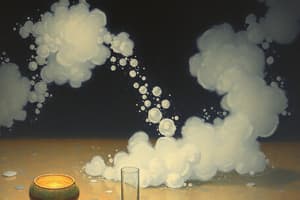Podcast
Questions and Answers
How does alum purify drinking water?
How does alum purify drinking water?
- It adds beneficial minerals to the water.
- It neutralizes colloidal particles in water. (correct)
- It filters out large particles.
- It chemically changes the water composition.
What is the effect of long-term dialysis on a colloidal solution?
What is the effect of long-term dialysis on a colloidal solution?
- The colloidal solution becomes more stable.
- The colloidal solution will precipitate. (correct)
- The colloidal solution forms a gel.
- The colloidal solution remains unchanged.
What effect does adding gelatin to gold sol have?
What effect does adding gelatin to gold sol have?
- It changes the sol from colloidal to crystalline.
- It stops the coagulation of gold sol. (correct)
- It enhances the color of the gold.
- It increases the size of gold particles.
What is peptization?
What is peptization?
What occurs when colloidal solutions of Fe(OH)3 and As2S3 are mixed?
What occurs when colloidal solutions of Fe(OH)3 and As2S3 are mixed?
What type of forces cause adsorption in physical adsorption?
What type of forces cause adsorption in physical adsorption?
Is adsorption an exothermic or endothermic process?
Is adsorption an exothermic or endothermic process?
Why are colloidal medicines considered more effective?
Why are colloidal medicines considered more effective?
What is meant by the gold number in colloidal chemistry?
What is meant by the gold number in colloidal chemistry?
What distinguishes physical adsorption from chemical adsorption?
What distinguishes physical adsorption from chemical adsorption?
Flashcards are hidden until you start studying
Study Notes
Alum Purification of Water
- Alum (KAl(SO4)2·12H2O) contains potassium (K+), aluminum (Al3+), and sulfate (SO42−) ions.
- These ions neutralize the charges of colloidal impurities in water.
- This causes the particles to coagulate, precipitate, and settle down, leading to clearer water.
Dialysis of Colloids
- Dialysis is the process of separating colloids from smaller molecules by using a semipermeable membrane.
- If a colloidal solution is dialyzed for an extended period, the colloidal particles will eventually precipitate out.
Gelatin and Gold Sol Coagulation
- Gelatin acts as a protective colloid.
- When added to gold sol, it prevents the coagulation of gold sol by forming a protective layer around the gold particles, hindering their aggregation.
Peptization
- Peptization is a process used to transform a freshly precipitated precipitate into a colloidal solution.
- This is achieved by adding a suitable electrolyte, which helps to disperse the precipitate particles, creating a stable colloidal suspension.
Precipitation of Colloidal Solutions
- Mixing positively charged Fe(OH)3 colloid with negatively charged As2S3 colloid leads to their neutralization.
- This neutralization causes both colloids to precipitate out of the solution.
Physical Adsorption: Van Der Waals Forces
- Physical adsorption, also known as physisorption, involves weak Van der Waals forces between adsorbate (the substance being adsorbed) and adsorbent (the surface).
- This type of adsorption is reversible and typically occurs at low temperatures.
Adsorption: Exothermic Process
- Adsorption is an exothermic process, meaning that heat is released during the process.
- The adsorption process is favored at lower temperatures.
Effectiveness of Colloidal Medicines
- Colloidal medicines have a larger surface area compared to non-colloidal forms due to their smaller particle size.
- This increased surface area allows for easier absorption and utilization by the body, improving their effectiveness.
Colloidal Medicines and Applications
- Silver sol (argyrol): Used as eye drops.
- Colloidal antimony: Used to treat kala-azar (a parasitic disease).
- Milk of magnesia emulsion: Used to treat upset stomach.
Carbon Monoxide (CO) in the Haber Process
- The Haber process is used to produce ammonia (NH3) from nitrogen and hydrogen gases.
- CO should be removed from the reaction mixture because it reacts with iron (Fe) to form iron carbonyl [Fe(CO)].
- Iron carbonyl is a solid at room temperature, which can impede the efficiency of the Haber process.
Gas Masks
- Gas masks are designed to protect individuals from harmful, toxic gases in the air.
- They contain activated charcoal, which acts as an adsorbent to remove the toxic gases.
- Gas masks are used in coal mines, industrial settings, and other environments where exposure to harmful gases is a concern.
Milk to Curd Conversion
- Lactic acid bacteria (LAB), primarily Lactobacillus, convert milk to curd.
- LAB ferment milk and produce lactic acid, which causes the coagulation of milk proteins, forming curd.
Gold Number
- Gold number is a measure of the protective power of a colloid.
- It represents the minimum concentration (in mg) of a protective colloid needed to prevent the coagulation of a specific volume of gold sol when a specific amount of electrolyte is added.
- A smaller gold number indicates a more effective protective colloid.
Key Differences between Physical and Chemical Adsorption
- Forces: Physisorption involves weak Van der Waals forces, while chemisorption involves strong chemical bonds.
- Reversibility: Physisorption is generally reversible, while chemisorption is often irreversible.
- Enthalpy (ΔH): Physisorption has low enthalpy change, while chemisorption has high enthalpy change.
- Surface Coverage: Physisorption leads to lower surface coverage, while chemisorption leads to higher surface coverage.
- Temperature Dependency: Physisorption increases at lower temperatures, while chemisorption increases at higher temperatures.
- Pressure Dependence: Physisorption generally increases with pressure, while chemisorption may or may not increase with pressure.
Studying That Suits You
Use AI to generate personalized quizzes and flashcards to suit your learning preferences.




